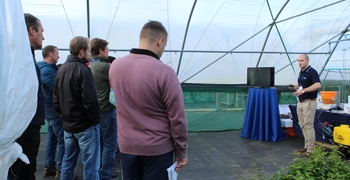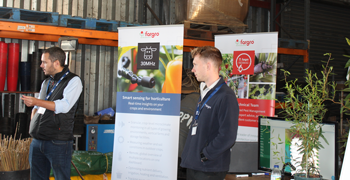"Timing and precision are everything” was the resounding take-home message given to those who attended ICL Professional Horticulture’s Hort Science Live event, held last month (October) at New Leaf Plants in Evesham, Worcestershire. There, more than 100 leading growers and industry professionals were given practical advice from a host of experts. Each of these speakers emphasised how good timing and precision are key to achieving the best possible results on the nursery.
ICL’s Sam Rivers highlighted the need to choose the right biological vine weevil control product for the time of year and the temperature. For example, liners brought into the nursery should be drenched with Vine Weevil Seeka when the temperature is above 12°C but Vine Weevil Seeka CT (Cold Tolerance) should be used when the temperature is lower than 12°C. Growers were also reminded that these should not be applied in direct sunlight as UV kills the nematodes in these products – which are best applied in wet and humid conditions.

ICL’s Andrew Wilson said that peat-free growing media can have a lower water holding capacity. “You might need to water them more but on top of that they tend to buffer nutrients less than peat does, so you could be watering more and losing more nutrients as well. We can design a nutrition package to take account of that.” He noted, for instance, that Osmocote N (5-6 month) and Osmoform High N can both gently release nitrogen over a longer period of time to counteract the leaching and uptake by bark and the wood fibre. Andrew also pointed out that ICL’s wetting agent, H2Gro, helps conserve water usage.

Fargro’s technical development specialist Ant Surrage also discussed the importance of good cultural practice, such as watering at the right moment. Fargro has been helping growers achieve this through its partnership with 30MHz, whose data platform ZENSIE is facilitated by sensors that are deployed in the crop canopy to read and log data such as temperature and vapour-pressure deficit (VPD). He said: “There’s always been the assumption that the glasshouse is a homogenous environment – but it’s not. For example, some areas get hotter during sunrise and stay hotter. Compare that with a map of volumetric water content and we can see where some areas are getting dried out.”

Delegates also learned that peat-free growing media – key blends of which have performed well in the five-year, industry- and government-supported Transition to Responsibly-Sourced Growing Media use in UK Horticulture project – can sometimes be easy to overwater as the surface dries out more quickly than peat.

Other helpful products that were discussed included ICL’s new biostimulants, Vitalnova Prima and Fortress, which ICL is making available to the ornamental sector from next year (2020). Martin Donnelly, ICL’s Sales Development Manager and Andrew Linscott, Technical Sales Manager for Alltech (who ICL are working with to bring these products to market), advised: “Growers need to Identify where the weaknesses are in their IPM plan and eliminate them, and improve growing practices by using the relevant biostimulant.” Certainly, there are many pest and diseases that pose a threat to UK nursery stock and so having a robust crop protection plan is vital. As growers were reminded, there are many products and tools available to them that, when used in a timely and precise way, can help their crops thrive.

